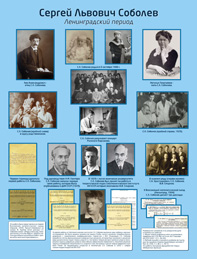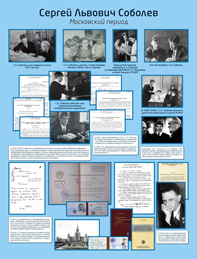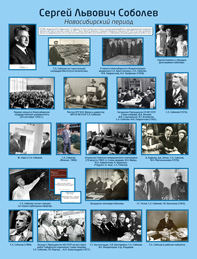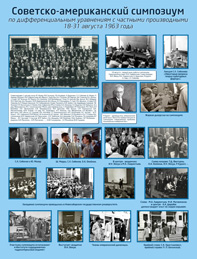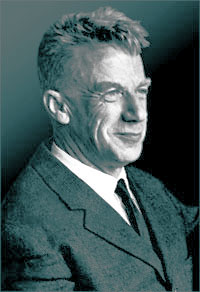
|
Sergei L'vovich Sobolev (1908-1989)
|
Sergei
L’vovich Sobolev was born in Saint Petersburg on October 6, 1908. His
father Lev Aleksandrovich Sobolev, a solicitor, participated in
revolutionary activities for which he was expelled from Saint Petersburg
University. His mother Natalia Georgievna Soboleva also was in her youth
a revolutionary and a member of the RSDLP. She taught literature and
history in a private school. Later she graduated from a medical school
and occupied a position of an assistant professor at the First Leningrad
Medical Institute. S.L. Sobolev was bereaved of his father in the early
childhood and his mother raised him to be honest, scrupulous, and
steadfast.
 S.L.
Sobolev was a very curious boy; he read a lot and liked mathematics,
physics, philosophy, biology, and medicine. He wrote poetry and learned
to play the piano. Graduating from secondary school in 1924, S.L.
Sobolev was too young to enter university. Young people under the age of
seventeen were admitted only according to the vouchers endorsed by the
principals of the parents' places of employment. Under these
circumstances, S.L. Sobolev entered the piano class of the First State
Arts School in 1924. The next year he was enrolled as a student at the
Physics and Mathematics Department of Leningrad State University, also
continuing his studies at the Arts School. Leningrad State University
was a great mathematical center that maintained remarkable traditions of
the Petersburg mathematical school famous for the discoveries by P.L.
Chebyshev, A.N. Korkin, A.M. Lyapunov, A.A. Markov, V.A. Steklov, and
others.
S.L.
Sobolev was a very curious boy; he read a lot and liked mathematics,
physics, philosophy, biology, and medicine. He wrote poetry and learned
to play the piano. Graduating from secondary school in 1924, S.L.
Sobolev was too young to enter university. Young people under the age of
seventeen were admitted only according to the vouchers endorsed by the
principals of the parents' places of employment. Under these
circumstances, S.L. Sobolev entered the piano class of the First State
Arts School in 1924. The next year he was enrolled as a student at the
Physics and Mathematics Department of Leningrad State University, also
continuing his studies at the Arts School. Leningrad State University
was a great mathematical center that maintained remarkable traditions of
the Petersburg mathematical school famous for the discoveries by P.L.
Chebyshev, A.N. Korkin, A.M. Lyapunov, A.A. Markov, V.A. Steklov, and
others.
At the university S.L. Sobolev attended the lectures by Professors N.M.
Gyunter, V.I. Smirnov, and G.M. Fikhtengolts, who influenced
considerably his uprise as a scientist. N.M. Gyunter supervised
Sobolev's graduation work on analytic solutions to a system of
differential equations in two independent unknowns which was published
at the Doklady of the USSR Academy of Sciences. After the graduation
from the university in 1929 S.L. Sobolev accepted a position in the
Theoretical Department, headed by V.I. Smirnov, of the Seismological
Institute of the USSR Academy of Sciences. During his stay at the
Seismological Institute S.L. Sobolev carried out several profound
scientific investigations. In collaboration with V.I. Smirnov he
developed the method of functionally invariant solutions and applied it
to solving a series of dynamical problems of elasticity. This method
provided a foundation for the theory of elastic wave propagation. In
particular: the famous Lamb problem of finding the displacement of an
elastic half-plane subject to a concentrated impulse was solved; a
rigorous theory of Raleigh surface waves was constructed; the problem of
diffraction of elastic waves near a spherical surface was solved; the
propagation of strong discontinuities was investigated in the problems
of elasticity.

S.L. Sobolev explained in detail the results concerning the dynamical
problem of elasticity in Chapter 12 (“Some Questions of the Propagation
Theory of Oscillations”) of the second part of the book “Differential
and Integral Equations of Mathematical Physics” by F. Frank and R. Mises
(1937). These results are used in the modern mathematical methods of
mineral prospecting, in the inverse problems of seismology, and in
studying cracks in elastic media.
The applied problems related to wave propagation in elastic media required
new approaches to partial differential equations. During this period
S.L. Sobolev began to study the Cauchy problem for hyperbolic equations
with variable coefficients. In 1930 at the First All-Union Mathematical
Congress in Kharkov S.L. Sobolev presented the talk “The Wave Equation
in an Inhomogeneous Medium”' in which he proposed a new method for
solving the Cauchy problem for the wave equation with variable
coefficients. The celebrated French mathematician J. Hadamard was in
attendance, and he remarked to S.L. Sobolev: “My young colleague, I
would be very happy if you could keep me up-to-date on your subsequent
work which I found greatly interesting.”
In 1932 S.L. Sobolev started working in the Department of Differential
Equations of the Steklov Mathematical Institute, and a year later for
his outstanding achievements in mathematics he was elected a
corresponding member of the USSR Academy of Sciences. The “Moscow period”
of Sobolev's career began in 1934. Together with the Steklov
Mathematical Institute he moved to Moscow and was appointed the head of
a department. During this period S.L. Sobolev obtained some fundamental
results in the theory of partial differential equations and functional
analysis that belong to the treasure trove of the world mathematics. The
ideas and methods of his articles were subsequently developed by many
mathematicians.
 Dealing
with the Cauchy problem for hyperbolic equations and discontinuous
solutions to elasticity theory equations led S.L. Sobolev to the concept
of a generalized solution to a differential equation, which plays a
fundamental role in the modern theory of partial differential equations.
In 1934 S.L. Sobolev presented three talks on the theory of partial
differential equations concerning problems of elasticity theory and the
Cauchy problem for hyperbolic equations at the Second All-Union
Mathematical Congress in Leningrad. The title of one of the talks was
“Generalized Solutions to the Wave Equation”. It was the birth of the
theory of generalized functions. In 1935-1936 S.L. Sobolev gave a
detailed exposition of the results presented in those talks in two
famous articles “General Theory of Diffraction of Waves on Riemann
Surfaces” and “A New Method of Solving the Cauchy problem for Linear
Normal Hyperbolic Equations”. In these articles the foundations of the
theory of generalized functions were explained in detail for the first
time.
Dealing
with the Cauchy problem for hyperbolic equations and discontinuous
solutions to elasticity theory equations led S.L. Sobolev to the concept
of a generalized solution to a differential equation, which plays a
fundamental role in the modern theory of partial differential equations.
In 1934 S.L. Sobolev presented three talks on the theory of partial
differential equations concerning problems of elasticity theory and the
Cauchy problem for hyperbolic equations at the Second All-Union
Mathematical Congress in Leningrad. The title of one of the talks was
“Generalized Solutions to the Wave Equation”. It was the birth of the
theory of generalized functions. In 1935-1936 S.L. Sobolev gave a
detailed exposition of the results presented in those talks in two
famous articles “General Theory of Diffraction of Waves on Riemann
Surfaces” and “A New Method of Solving the Cauchy problem for Linear
Normal Hyperbolic Equations”. In these articles the foundations of the
theory of generalized functions were explained in detail for the first
time.
The emergence of the theory of generalized functions had been based on the
development of real analysis and theoretical physics. The available
ideas of Heaviside, Dirac, Kirchhoff, and Hadamard aided in the
emergence of the theory. However, the works of predecessors contained
neither concepts nor constructions similar to the rigorous constructions
of S.L. Sobolev. It is worth mentioning that for S.L. Sobolev his
generalized functions were primarily some mathematical tools of import
to applications.
During the subsequent years S.L. Sobolev advanced the theory of
generalized functions in a new direction. He introduced and studied the
new spaces of functions which based on the concept of a generalized
derivative and became acknowledged in the literature as Sobolev spaces.
For these spaces S.L. Sobolev proved the first embedding theorems, and
used the spaces to investigate boundary value problems for high order
elliptic equations. In 1939 he published the paper “To the Theory of
Nonlinear Hyperbolic Partial Differential Equations” in which he used
his theory of function spaces and solved the Cauchy problem for second
order quasilinear hyperbolic equations.
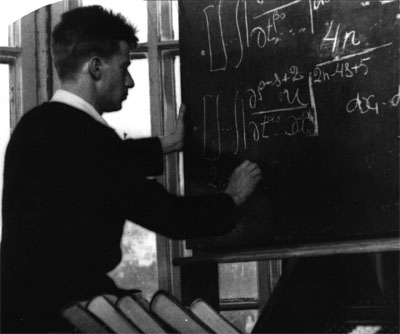 The
systematic exposition of the theory of function spaces, embedding
theorems for these spaces, trace theorems, and applications of these
results to problems in partial differential equations and equations of
mathematical physics is set forth in Sobolev's famous book “Some
Applications of Functional Analysis in Mathematical Physics” (1950).
This book became a standard reference not only for mathematicians, but
also for those working in many other areas of science. There were three
editions in USSR and two editions of the English translation in the USA.
This book was also translated into many other languages. The concepts of
a generalized derivative and a generalized solution became universal.
The theory of Sobolev spaces appeared as a new section of study in
mathematics. S.L. Sobolev not only laid the foundations of the theory of
generalized functions and new function spaces, but also he showed their
practical applications in studying boundary value problems for
differential equations.
The
systematic exposition of the theory of function spaces, embedding
theorems for these spaces, trace theorems, and applications of these
results to problems in partial differential equations and equations of
mathematical physics is set forth in Sobolev's famous book “Some
Applications of Functional Analysis in Mathematical Physics” (1950).
This book became a standard reference not only for mathematicians, but
also for those working in many other areas of science. There were three
editions in USSR and two editions of the English translation in the USA.
This book was also translated into many other languages. The concepts of
a generalized derivative and a generalized solution became universal.
The theory of Sobolev spaces appeared as a new section of study in
mathematics. S.L. Sobolev not only laid the foundations of the theory of
generalized functions and new function spaces, but also he showed their
practical applications in studying boundary value problems for
differential equations.
The ideas and methods of S.L. Sobolev have been intensively developed
and gained applications in differential equations, equations of
mathematical physics, and computational mathematics. His embedding and
trace theorems have turned into one of the most important tools of the
modern real analysis.
In 1939 for his outstanding mathematical discoveries S.L. Sobolev was
elected into the USSR Academy of Sciences, remaining for a long time the
youngest member of the Academy. His wife Ariadna Dmitrievna Soboleva
recalled that S.L. Sobolev had often said that he had been in debt to
the USSR Academy of Sciences and that he would try to live up to his
status of an academician. While talking to journalists many years later,
S.L. Sobolev said: “As for my articles, at the time of my election no
one could foresee what would grow out of them, and so my election into
the Academy was a credit given to me”.
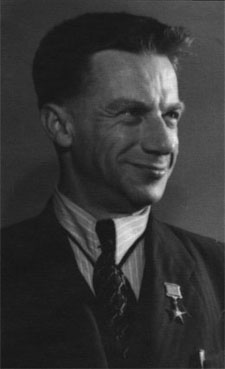 In
1941, at the very beginning of the Great Patriotic War, Academician S.L.
Sobolev took up the responsibilities of the Director of the Steklov
Mathematical Institute. In the difficult conditions of evacuation to
Kazan S.L. Sobolev contributed much to organizing applied research in
the Institute and helping effectively to the Soviet Army. When the
Steklov Mathematical Institute returned back to Moscow in 1943, S.L.
Sobolev was transferred to Laboratory No 2 (LIPAN, the Russian acronym
for the Laboratory of Measuring Instruments of the USSR Academy of
Sciences) headed by Academician I.V. Kurchatov, which was later
transformed into the Kurchatov Institute of Atomic Energy. S.L. Sobolev
was appointed the First Deputy Director and the Head of the Scientific
Council of the Institute. Since then the name of S.L. Sobolev
disappeared from the press for a long time.
In
1941, at the very beginning of the Great Patriotic War, Academician S.L.
Sobolev took up the responsibilities of the Director of the Steklov
Mathematical Institute. In the difficult conditions of evacuation to
Kazan S.L. Sobolev contributed much to organizing applied research in
the Institute and helping effectively to the Soviet Army. When the
Steklov Mathematical Institute returned back to Moscow in 1943, S.L.
Sobolev was transferred to Laboratory No 2 (LIPAN, the Russian acronym
for the Laboratory of Measuring Instruments of the USSR Academy of
Sciences) headed by Academician I.V. Kurchatov, which was later
transformed into the Kurchatov Institute of Atomic Energy. S.L. Sobolev
was appointed the First Deputy Director and the Head of the Scientific
Council of the Institute. Since then the name of S.L. Sobolev
disappeared from the press for a long time.
The top secret laboratory worked intensely to build a nuclear shield of
the USSR. This was a period of hard creative work for the members of the
staff of the Institute. S.L. Sobolev collaborated with physicists,
Academicians I.V. Kurchatov, I.K. Kikoin, M.A. Leontovich, and others.
The physical process under study had to be understood as a whole, and
the impending particular problems had to be solved using rather limited
computational facilities. S.L. Sobolev faced the applied mathematical
problems that took tremendous effort because it was required to
calculate, optimize, and predict extremely complicated processes never
studied before. The extraordinary mathematical intuition and great labor
were needed in order to solve the intricate special problems thoroughly
and timely. His wife Ariadna Dmitrievna recalled: “During his work at
the Institute of Atomic Energy he might be absent from home for months
and frequently left for long and distant trips”. For his exceptional
services to the State in these years, S.L. Sobolev was awarded two State
Prizes and the title of the Hero of the Socialist Labor.
In the 1950s S.L. Sobolev published his famous book “Some Applications
of Functional Analysis in Mathematical Physics” (1950) and several
fundamental papers on partial differential equations, functional
analysis, and computational mathematics. In particular, his celebrated
article “On a new problem of mathematical physics” (1954) initiated the
systematic investigations of the new classes of equations and systems
not solvable with respect to the highest-order derivative. Such
equations are now called the “Sobolev type equations” in the literature.
The problems of the kind were motivated by studying rotating fluids
(1943). For this work S.L. Sobolev received a State Prize in 1986.
During the 1950s S.L. Sobolev paid great attention to the problems of
computational mathematics as well. In particular, he developed the
concept of the closure of a computational algorithm, studied the
discrete problems that arise in approximating differential and integral
equations. S.L. Sobolev recalled: “Working in the Institute of Atomic
Energy, I got a taste of computational mathematics and realized its
exceptional potential. Thus, I accepted with great pleasure an offer by
I.G. Petrovskii to head the Chair of Computational Mathematics of Moscow
State University, the first chair in this area in our country”. S.L.
Sobolev headed the chair since 1952 to 1958. During this time together
with A.A. Lyapunov he actively defended cybernetics, making a case for
its significance.
 In
1956 Academicians M.A. Lavrentiev, S.L. Sobolev, and S.A. Khristianovich
came forward with a proposal to work out a plan for creating scientific
centers in the eastern regions of the USSR. In 1957 the Government
decided to organize the Siberian Branch of the USSR Academy of Sciences
which will consist of several research institutes, including the
Institute of Mathematics. Academician S.L. Sobolev was appointed the
Director of the Institute. In 1958 the “Siberian period” of Sobolev's
career began. S.L. Sobolev spent a year in Moscow to fill the positions
in several departments of the future Institute of Mathematics and then
he moved with his colleagues to the permanent residence in Novosibirsk.
“Many people, even friends, could not understand what exactly had driven
me”, S.L. Sobolev said, “to leave the strong chair at Moscow State
University and go to Siberia which was in actuality a scientifically
virgin land”. His own answer to this question was, as always, remarkably
modest: “It was the natural desire of a man to live several lives, to
start something new”.
In
1956 Academicians M.A. Lavrentiev, S.L. Sobolev, and S.A. Khristianovich
came forward with a proposal to work out a plan for creating scientific
centers in the eastern regions of the USSR. In 1957 the Government
decided to organize the Siberian Branch of the USSR Academy of Sciences
which will consist of several research institutes, including the
Institute of Mathematics. Academician S.L. Sobolev was appointed the
Director of the Institute. In 1958 the “Siberian period” of Sobolev's
career began. S.L. Sobolev spent a year in Moscow to fill the positions
in several departments of the future Institute of Mathematics and then
he moved with his colleagues to the permanent residence in Novosibirsk.
“Many people, even friends, could not understand what exactly had driven
me”, S.L. Sobolev said, “to leave the strong chair at Moscow State
University and go to Siberia which was in actuality a scientifically
virgin land”. His own answer to this question was, as always, remarkably
modest: “It was the natural desire of a man to live several lives, to
start something new”.
Heading the Institute of Mathematics, S.L. Sobolev aimed to represent in
the Institute all principal directions of the contemporary mathematics.
The Department of Algebra and Logic in the Institute developed
successfully under the guidance of Academician A.I. Mal’tsev;
Academician A.D. Alexandrov led geometric research; Academician L.V.
Kantorovich headed the Department of Mathematical Economics; Academician
G.I. Marchuk did the Department of Computational Mathematics; A.A.
Lyapunov, Corresponding Member of the USSR Academy of Sciences, headed
the Department of Theoretical Cybernetics. S.L. Sobolev himself led
research into differential equations and functional analysis. Greatly
helpful to S.L. Sobolev in running the Institute was his deputy A.I.
Shirshov, Corresponding Member of the USSR Academy of Sciences. In a
very short time the Institute of Mathematics became a world renowned
mathematical center.
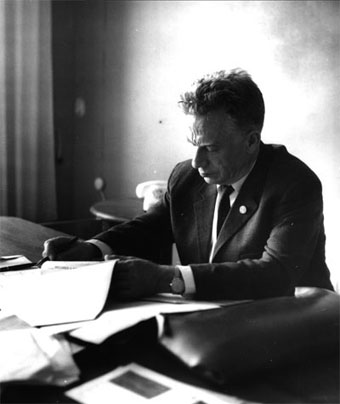 S.L.
Sobolev was one of the founders of Novosibirsk State University. He gave
the first lecture on mathematics at the university. He headed the Chair
of Differential Equations, gave a regular course in equations of
mathematical physics and a special course in cubature formulas, and
coordinated the work of special seminars.
S.L.
Sobolev was one of the founders of Novosibirsk State University. He gave
the first lecture on mathematics at the university. He headed the Chair
of Differential Equations, gave a regular course in equations of
mathematical physics and a special course in cubature formulas, and
coordinated the work of special seminars.
During his “Siberian period” S.L. Sobolev began research into a new
area: cubature formulas. He said, “After the transfer from Moscow to
Novosibirsk I got preoccupied with cubature formulas. It so happened
that they made me come back to the classical works of Euler. I had to
investigate some properties of Euler polynomials that had not been known
to the great classic of mathematics. It was like returning back to the
origins”.
The approximate integration of a function is among the main problems of
the theory of computation. The case of multidimensional integrals is
extremely laborious in the computational aspects. As a result of
studying the new problems of functional analysis, partial differential
equations, and function theory, with a view towards solving the problems
of computational mathematics, S.L. Sobolev expounded and created the
theory of cubature formulas. In Novosibirsk S.L. Sobolev wrote the
definitive monograph “Introduction to the Theory of Cubature Formulas”
which was published in 1974. The book summarized the author's research
into cubature formulas in the lapse of many years.
In 1983 the “Siberian period” of Sobolev's career terminated, and in
1984 he returned to Moscow to continue his work at the Steklov
Mathematical Institute in the department headed by Academician S.M.
Nikolskii.
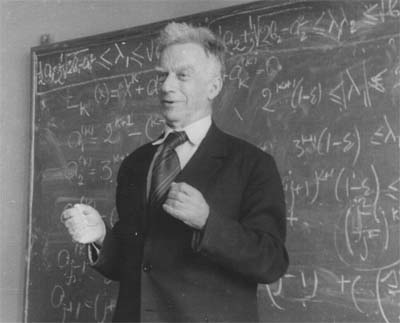 The
remarkable scholar and public figure, S.L. Sobolev was a great teacher
who brought up a huge group of talented students and followers. He
taught at Leningrad State University, the Leningrad Electrotechnical
Institute, the Red Army Transport Academy, Moscow State University, the
Moscow Institute of Physics and Technology, and Novosibirsk State
University.
The
remarkable scholar and public figure, S.L. Sobolev was a great teacher
who brought up a huge group of talented students and followers. He
taught at Leningrad State University, the Leningrad Electrotechnical
Institute, the Red Army Transport Academy, Moscow State University, the
Moscow Institute of Physics and Technology, and Novosibirsk State
University.
The brilliant scientific career and public activity of S.L. Sobolev that
made his great reputation in the USSR received a proper international
recognition. He was a foreign member of the French Academy of Sciences,
the Accademia Nazionale dei Lincei in Rome, a foreign member of the
Academy of Sciences in Berlin, an honorary member of the Edinburgh Royal
Society, an honorary member of the Moscow Mathematical Society and the
American Mathematical Society. He received honorary degrees from various
universities of the world. The contributions of S.L. Sobolev had earned
him many state awards. In 1989 S.L.Sobolev was awarded the highest prize
of the USSR Academy of Sciences, the Lomonosov Gold Medal, for his
outstanding achievements in mathematics.
Sergei L’vovich Sobolev passed away in Moscow on January 3, 1989. He is
buried at Novodevichy Cemetery.
Bio-bibliographic materials
-
Sobolev Sergei L'vovich (1908-1989). Bio-bibliography (in Russian)
-
Sergei L'vovich Sobolev (MacTutor History of Mathematics)
-
Sergei L'vovich Sobolev (Mathematical Genealogy Project )
-
Academician Sergey L'vovich Sobolev (Branch of State Public Scientific Library SB RAS; in English, in Russian)
Chronological indices of S.L. Sobolev's works
-
Publications (Sobolev Institute of Mathematics SB RAS)
-
Bibliography of S.L. Sobolev's works (Branch of State Public Scientific Library SB RAS; in Russian)
Papers on S.L. Sobolev's life and work
-
Papers on S.L. Sobolev's life and work (Branch of State Public Scientific Library SB RAS; in Russian)
-
References for Sergei Sobolev (MacTutor History of Mathematics)
-
Sergei L'vovich Sobolev on his sixtieth birthday (Sib. Math. J. 9 (1968), No. 5)
-
Sergei L'vovich Sobolev on the occasion of his seventieth birthday (Sib. Math. J. 19 (1978), No. 5)
-
Sergei L'vovich Sobolev (on his seventieth birthday) (P.S. Aleksandrov, R.A. Aleksandryan, V.M. Babich, N.S. Bakhvalov, O.V. Besov, L.V. Kantorovich, V.I. Lebedev, V.N. Maslennikova, O.A. Oleinik, S.V. Uspenskii; Russ. Math. Surv. 34 (1979), No. 1)
-
Sergei L'vovich Sobolev (on his eightieth birthday) (N.S. Bakhvalov, A.A. Gonchar, L.D. Kudryavtsev, V.I. Lebedev, S.M. Nikol'skii, S.P. Novikov, O.A. Oleinik, Yu.G. Reshetnyak, V.S. Vladimirov; Russ. Math. Surv. 43 (1988), No. 5)
-
Remembrances of Sergei L'vovich Sobolev (M.M. Lavrent'ev, Yu.G. Reshetnyak, A.A. Borovkov, S.K. Godunov, T.I. Zelenyak, S.S. Kutateladze; Sib. Math. J. 30 (1989), No. 3)
-
Academician Sergei L'vovich Sobolev (on his ninety-fifth birthday) (S.S. Kutateladze; Vladikavkaz Math. J. 5 (2003), No. 4; in Russian)
-
Sobolev of the Euler school (S.S. Kutateladze; Sib. Math. J. 49 (2008), No. 5)
-
Sergei L. Sobolev (G.V. Demidenko; Newsletter of the European Mathematical Society (2008), No. 70, pp . 33-35)
Commemorative plaque on the building of the Sobolev Institute of Mathematics SB RAS
Boards devoted to S.L. Sobolev (Sobolev Institute of Mathematics
SB RAS)
Photos of S.L. Sobolev
-
Sergei L'vovich Sobolev (Sobolev Institute of Mathematics SB RAS)

